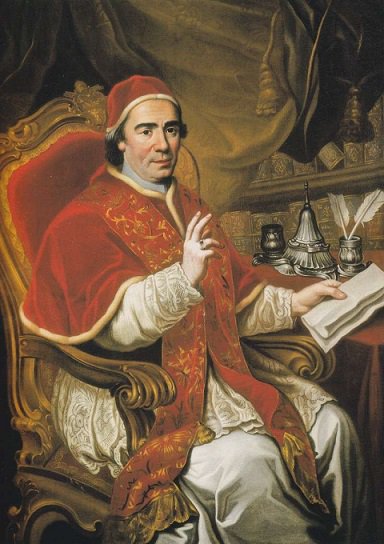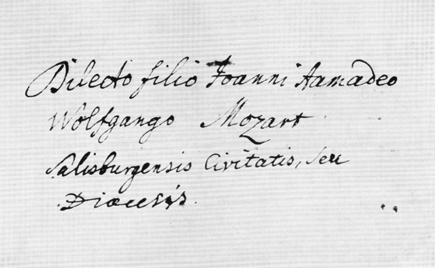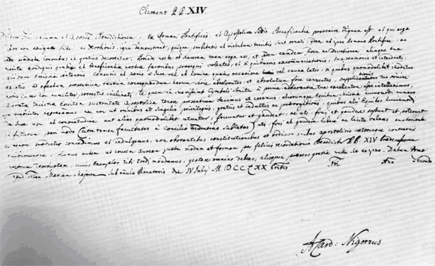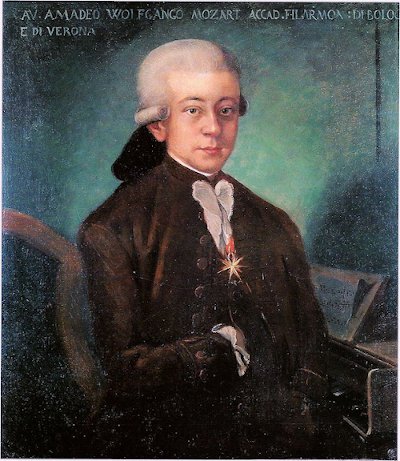Pope from 19 May 1769-22 September 1774. Born Giovanni Vincenzo Antonio Ganganelli, Clement XIV was educated by the Jesuits at Rimini and the Piarists at Urbino. A friend of Pope Benedict XIV, he was appointed Cardinal at San Lorenzo in Panisperna in 1759 and elected Pope in 1769; his papacy is known for his suppression of the Jesuit order (in his bull of 16 August 1773, Dominus ac Redemptor noster) and his founding of Museo Pio-Clementino.

Anon, Clement XIV, 1772 (Vatican Museums)
- Mozart Relevance
-
On 4 July 1770, Leopold wrote to his wife: ‘Tomorrow we`re to hear a piece of news which, if it`s true, will amaze you. Cardinal Pallavicini is said to have received instructions from the pope to confer the cross and diploma of an order on Wolfg. Don`t say much about this yet: I`ll write again next Saturday to let you know if it`s true. Recently, while we were at the cardinal’s house, he kept calling Wolfg. `Signore Cavaliere`, we thought it was a joke. But now I hear that it`s true and that this is why he`s invited us tomorrow.’
The papal order, together with its insignia, was – as Leopold guessed – presented to Mozart on 5 July. The text of Clement XIV’s patent reads:
Our beloved Son greetings and apostolic benediction. Inasmuch as it behoves the beneficence of the Roman Pontiff and the Apostolic See that those who have shown them no small signs of faith and devotion and are graced with the merits of probity and virtue, shall be decorated with the honours and favours of the Roman Pontiff and the said See: We, therefore, wishing to honour thee with fitting tokens of our grace and beneficence on account of thy sincere faith and devotion to us and the aforesaid See, together with thy other merits, hereby absolve thee, in so far as shall give effect and consequence to these presents, from any sentence of excommunication, suspension and interdict, or other censure and penalties of the Church impose by law or man for whatever occasion or cause, if in any way whatsoever thou art enmeshed in them: And deeming thee to be thus absolved, and hearkening to the supplications humbly submitted to us on thy behalf in this matter, we hereby make and create thee – whom we understand to have excelled since thy earliest youth in the sweetest sounding of the harpsichord – Knight of the Golden Order, by the Apostolic authority and the terms of these presents: Receiving thee favourably into the number of Knights of the said Order, especially that thou mayst in like manner freely and lawfully use and enjoy each and all of the privileges and prerogatives which the other Knights of the Order enjoy by law usage, custom or in any other way, and shall in future enjoy (excepting such as have been abolished by the Council of Trent), notwithstanding any apostolic or other constitutions or ordinances to the contrary whatsoever.
Wherefore it is our wish that though shalt at all times wear the Golden Cross (for otherwise there is no present grace in the object itself) according to the manner and form laid down by our predecessor Benedict P.P. XIV of happy memory, of which we command a copy to be present to thee.
Given at Rome at S. Maria Maggiore under the Fisherman’s ring, the 4th day of July 1770, in the second year of our Pontificate.
A. Card Nigornus

Papal patent (1)

Papal patent (2)
MDB, 123-124. A copy made for Padre Martini survives in the library of the Bologna Conservatory. The insignia of the order includes a golden cross on a red sash, with sword and spurs. In 1777, Leopold Mozart sent Padre Martini a portrait of Mozart wearing the cross.

Anon, Mozart wearing the Order of the Golden Spur, Salzburg 1777
- Category/Role
- Pope
- Date 1
- 1705-10-31, Sant' Arcangelo di Romagna
- Date 2
- 1774-09-22, Sant' Arcangelo di Romagna
- Date (Mozart)
- 1770-07-04
- Location (Mozart)
- Rome
- Bibliographic Reference
- Catholic Encyclopedia